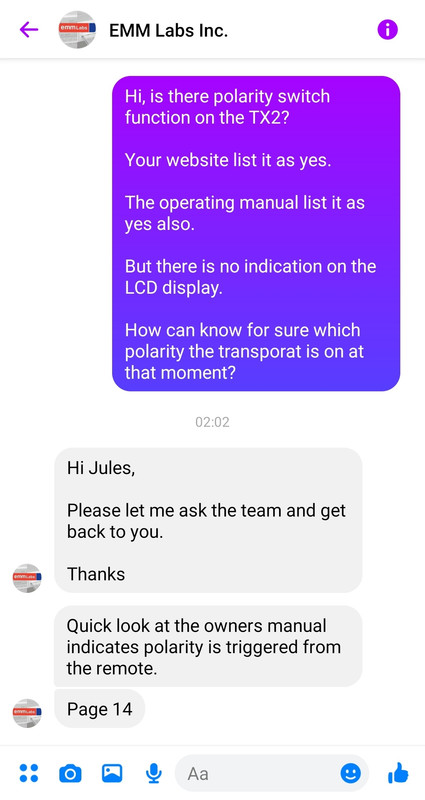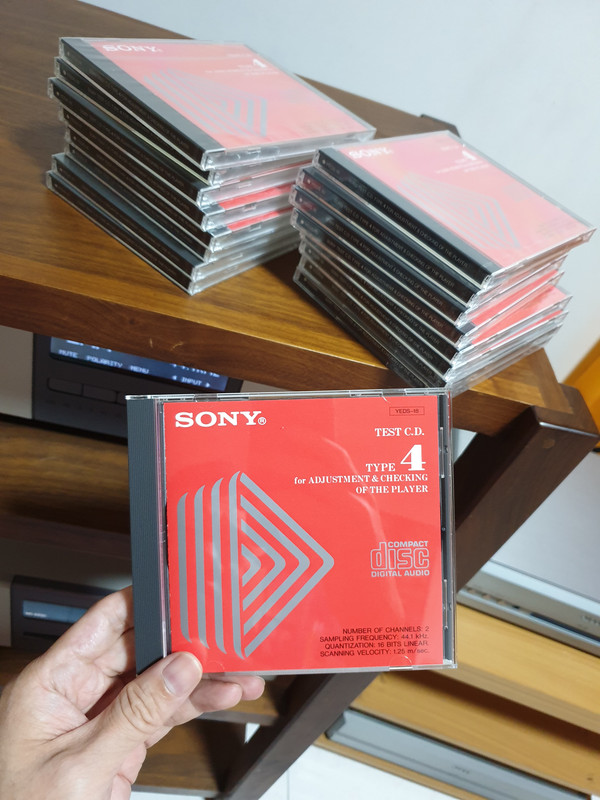As to Polarity EMM writes,
I received similar reply.
The EMM LABS TX2 transport is listed on their website as having polarity switching function. It is also mentioned in their owner's manual it has polarity switching function. The problem is - there is no polarity status indicator on the TX2 display screen.
When asked about this, Amadeus Meitner (supposedly) checked with their engineers and then replied that the TX2 doesn't actually have this feature, and they had erroneously included on their website and manual. (This product has been in the market since 2016!!!)
He further said that while the transport will recognised the infrared signal being received, it will not do anything.
However,...
....after having tried many discs, I can say I definitely heard differences in every case between the 2 settings.
What is happening here!???!?
That means the transport can actually switch polarity, but there is no status indicator so user will not know unless they take effort to listen and check carefully.
So now I am really pissed because I had listened to the wrong polarity for the whole of last 1 year....
I had never used the remote to change polarity until last week. I have always believe in not using remote controls because of the detrimental effects that can have subsequently on the audio quality (I recently mentioned about this in the soulnote s3v2 player thread. And after that I found that the TX2 and DA2 are actually much less susceptible to the detriment that remote controls can wrought.) Because of this, when I was pondering about the polarity issue on the emm transport, I was encouraged to use the remote to check polarity on the transport.
After each polarity presses aiming towards the transport, and covering the dac display panel to ensure not affecting it as well, I was shocked that I can hear distinct sound differences in imaging delineation, palpability, dynamic impact and detail resolution.
To ensure that what I'm hearing is not due to any additional effects brought on by the remote control infrared codes entering into the transport, possibly causing momentarily disruption to the transport's power supply, and subsequently it's sound quality, I used the following method of checking:
Cover DA2 display panel
Press polarity button and aim at the TX2
Check TX2 display panel for the momentary indicator at the bottom right hand corner that command codes have been received
Power off the DA2 (using rocker switch at the back panel)
Power off the TX2 (using rocker switch at the back panel. Power off at the mains switch)
Power up the TX2
Load a cd. Let it read TOC and settle
Power up the DA2
Press [PLAY] button on the TX2
Using the above methods i cue up music from different CDs to play. And between the 2 polarity presses, subsequently I heard changes in imaging delineation, palpability, dynamic impact and detail resolution. The sonic differences are so distinct I could easily identify which polarity status I had been listening for that last 1 year, and it had been the wrong one!!!
What this means is that despite what EMM Labs is claiming, the polarity button on their remote control does affect their TX2 transport, and that each polarity status carried on even after the transport has been switched off completely with the rocker switch at the back and from the mains switch.
I had not wanted to share my findings until I have gotten some measurements to certify my listening tests. I am the midst of getting a quote of the shipping cost from Amadeus Meitner for the TSDX remote and new simplified DA2 remote, and I know now he is probably monitoring this thread since yesterday, he just shared the photos of your setup from the Meitner power amp thread on their company Facebook page.
I am not sure whether there could be any disruption to our agreement after he reading this, but I think since you are testing their power amps for a limited time only, you need to ensure that your TX2 is set to the correct polarity, since, as you mentioned previously, you had also pressed the polarity button and aimed at the transport a few times.
As for measurements I was told that the best way to test this would be using a test CD with a sine wave signal. If the output is connected to an oscilloscope or similar test equipment that can display a time-varying signal (some PC software are said to be able to do this). I was told that i can then see the sine wave flip its polarity if inverted. According a speaker designer friend (He uses Playback Design MPT-8/MPD-8) there are hand held devices and software that can display this, in addition to traditional digital scopes and audio analyzers. I am now looking for a low cost pc-based kit on line.















